What to Expect After Giving Birth

Disclaimer: This information provided by Kennedy Johnson Schwabe & Roberge P.C. is for informational purposes only and should be in no way construed as medical or legal advice.
Childbirth is a physically and emotionally challenging experience, and new mothers can have symptoms for months afterward. Pain, bleeding, fatigue, and other effects are normal, but some complications are a sign of medical negligence.
In this guide, you’ll learn what to expect after giving birth, when your symptoms might be a sign of something more severe, and what legal rights you have if you suffered harm due to medical negligence.
What To Expect From Your Physical Recovery in the First Six Weeks
The physical recovery from childbirth usually lasts six to eight weeks, but every case is unique, and timelines vary. Your body undergoes significant changes during pregnancy, shifting back to your pre-pregnancy state after your baby is born. Many of the symptoms you experience during the first six weeks are part of this process.
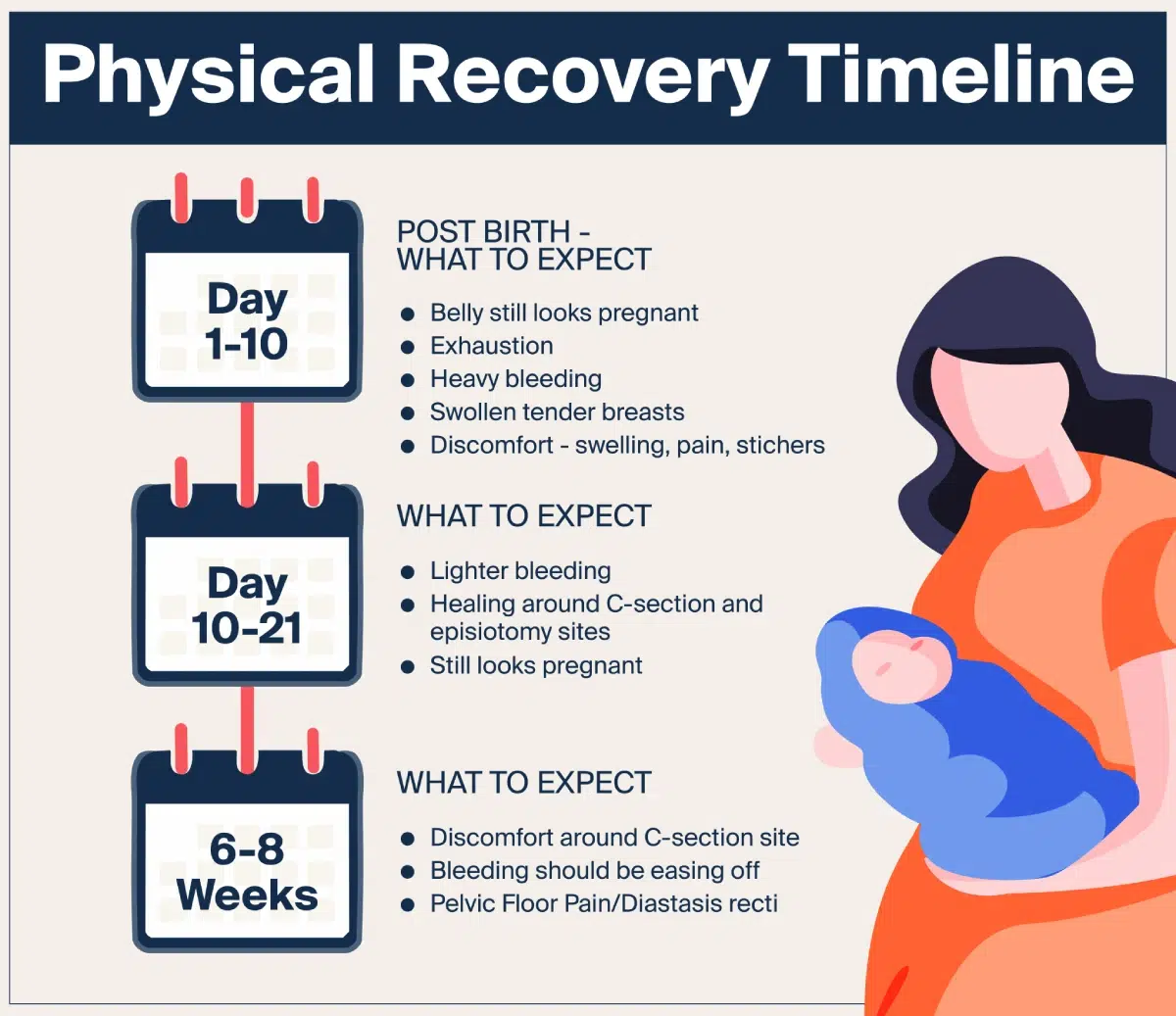
Vaginal and Cesarean Deliveries
Your experience will differ based on whether it’s a vaginal or cesarean section recovery. In both cases, you can have hot flashes, headaches, and mood changes as your hormone levels shift. In addition, uterine shrinkage—when your uterus returns to its previous size—often causes cramping and bleeding.
Vaginal deliveries typically have shorter and less painful recovery periods, but most women have some level of soreness and bleeding. If your perineum tears during birth, your recovery may be longer and more painful.
A cesarean section, or C-section, is a major surgery where the doctor makes an incision in your lower abdomen and uterus. Although you will receive medictation before the surgery so won’t feel anything during the delivery, your pain during recovery will likely be greater than a vaginal delivery recovery.
Mothers who undergo C-sections have longer hospital stays, typically between three and four days. You may also need painkillers to help with the tenderness and pain at the incision site. Your doctor will probably tell you to restrict your activity, instructing you not to bend down and lift objects for several weeks. After one to two months, you can gradually return to normal movement and engage in gentle postpartum exercise.
Incision Care
Your incision is another factor at play during C-section recovery. Your health care team will instruct you on how to care for the wound, but you will generally need to clean and dry it daily.
Wearing loose, comfortable clothes can minimize your discomfort. As your incision heals, look for signs of infection, such as redness, swelling, or leaking fluid. If you suspect an infection, reach out to your medical provider so they can examine and treat it.
Wearing loose
Look for signs of infections
- Redness
- Swelling
- Leaking fluid
Reach out to your medical provider
Understanding Postpartum Bleeding and Lochia
Women usually have vaginal discharge, or lochia, for several days or weeks after giving birth. It is a mixture of blood, mucus, amniotic fluid, and uterine tissue. While this might be worrying for first-time moms, it’s a normal part of postpartum healing.
Lochia progresses through the following three stages:
- Lochia rubra: The discharge is heavy, dark, or bright red in color, and may involve some small clots and cramping.
- Lochia serosa: Your discharge flow decreases and becomes a lighter, more pinkish brown color with a thinner consistency.
- Lochia alba: The lochia will take on a yellow or white hue with little to no blood.
While these lochia stages aren’t usually cause for concern, monitor your discharge for signs of a problem. Lochia with large blood clots, excessive blood, or a strong smell can indicate an infection or hemorrhage.
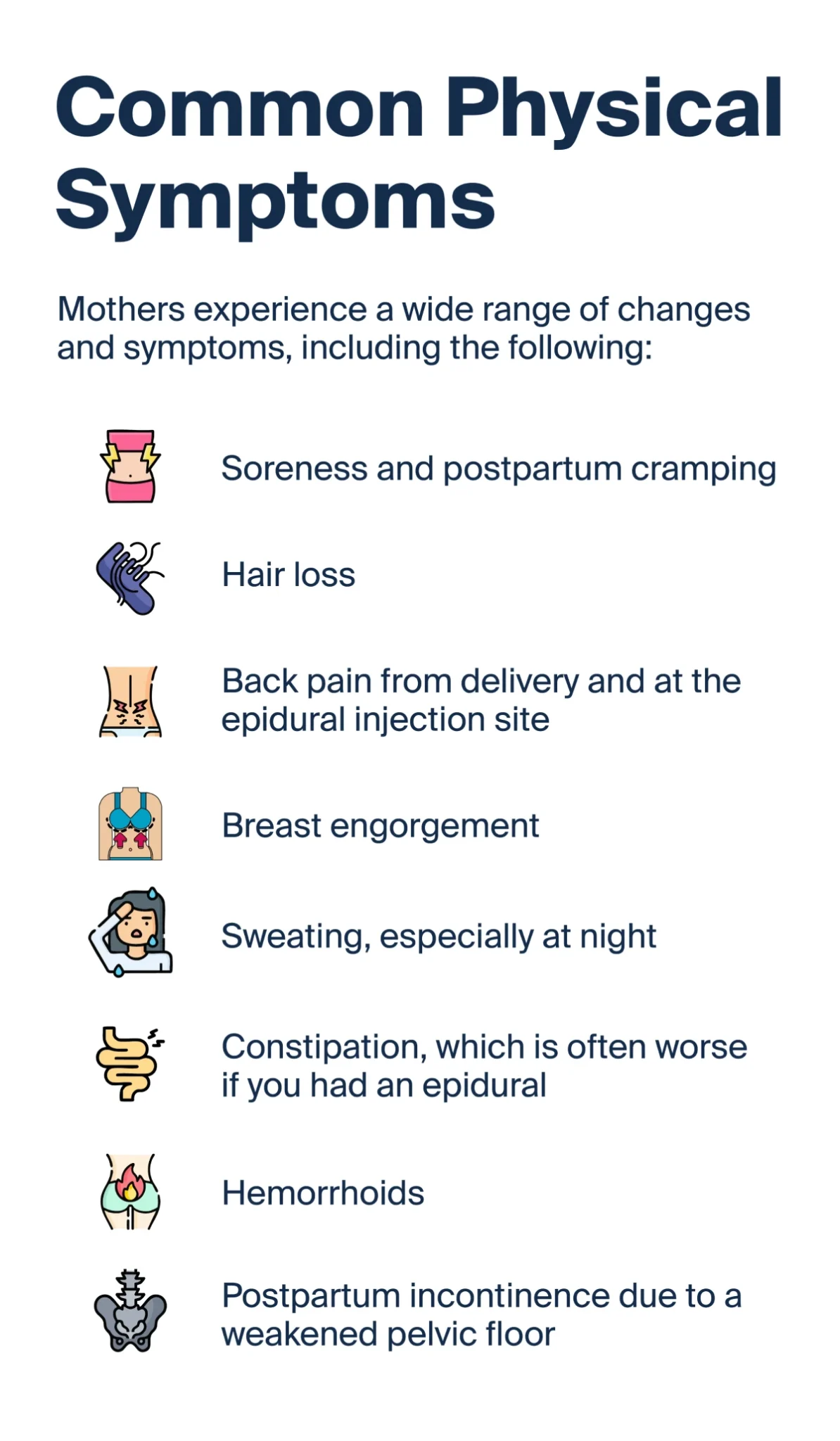
Common Physical Symptoms
Mothers experience a wide range of changes and symptoms, including the following:
- Soreness and postpartum cramping
- Hair loss
- Back pain from delivery and at the epidural injection site
- Breast engorgement
- Sweating, especially at night
- Constipation, which is often worse if you had an epidural
- Hemorrhoids
- Postpartum incontinence due to a weakened pelvic floor
You can address many of these symptoms at home with rest and over-the-counter painkillers. Your doctor may also prescribe stool softeners to help with constipation. Perineal care, such as sitting on a soft pillow and using ice packs, can reduce soreness. However, if you notice any of your symptoms are persistent or worsening, you may have a more serious complication requiring evaluation and treatment.
Red Flags That May Indicate a Medical Error
Monitoring your own health is vital after childbirth because even small changes can alert you to a significant problem. Watch for these red flags, which often occur during an urgent medical complication:
- Excessive bleeding
- Severe pain
- High fever
- Persistent and severe headaches
- Vision changes
- Dizziness or fainting
- Swelling
- Difficulty breathing
- Nausea and vomiting
In some situations, these issues develop because of an error by your health care team. For example, improper use of medical tools, incorrect medication administration, and improper wound care can result in an otherwise preventable infection or illness. If that happens, seek immediate medical attention. Also, consider consulting an attorney to review your case once your health stabilizes.
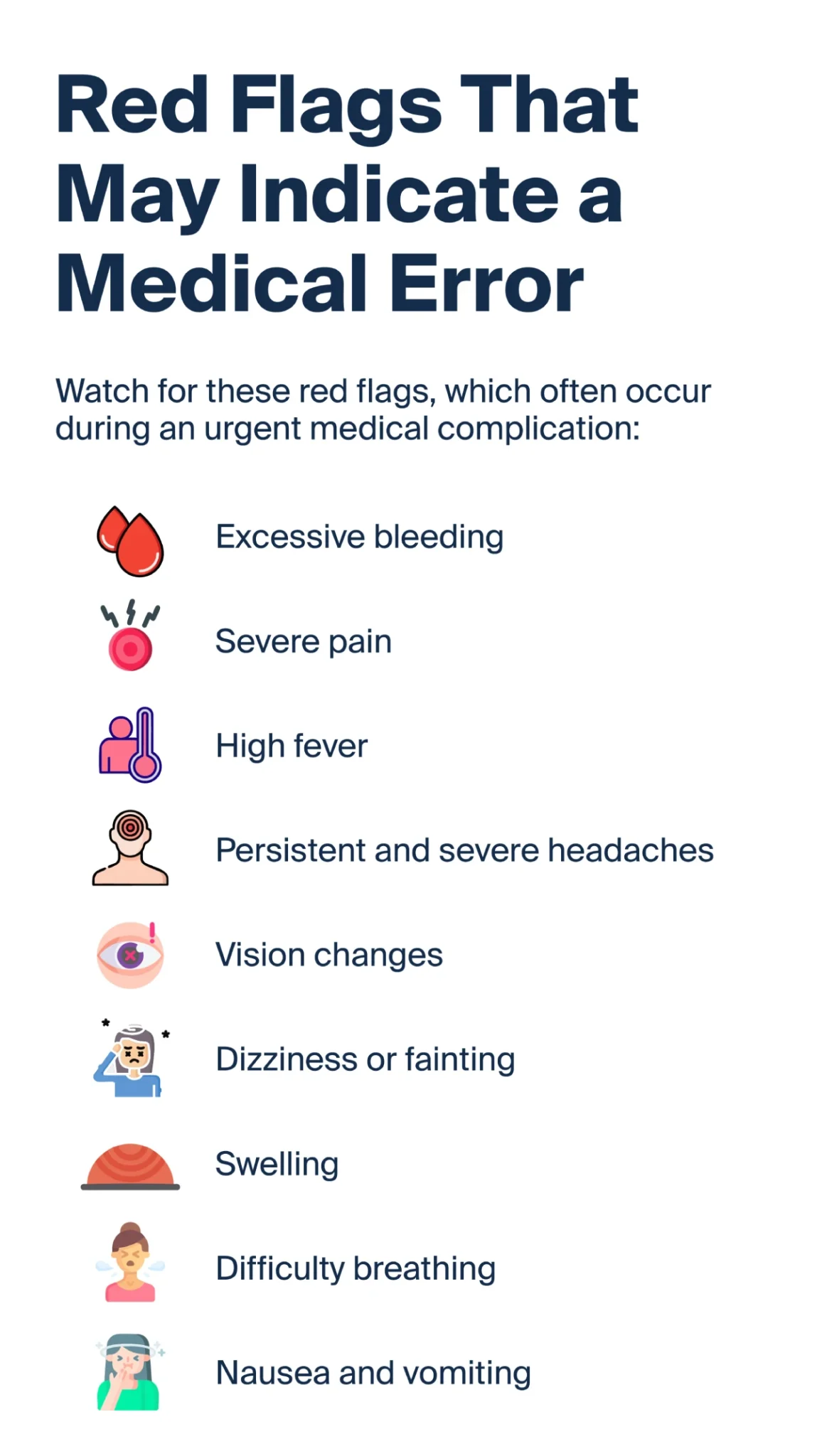
Emotional and Mental Health After Birth
Your physical health isn’t the only concern after childbirth—your emotional well-being is equally important. Hormonal shifts, life changes, and other factors can cause distress and trigger or exacerbate mental health conditions.
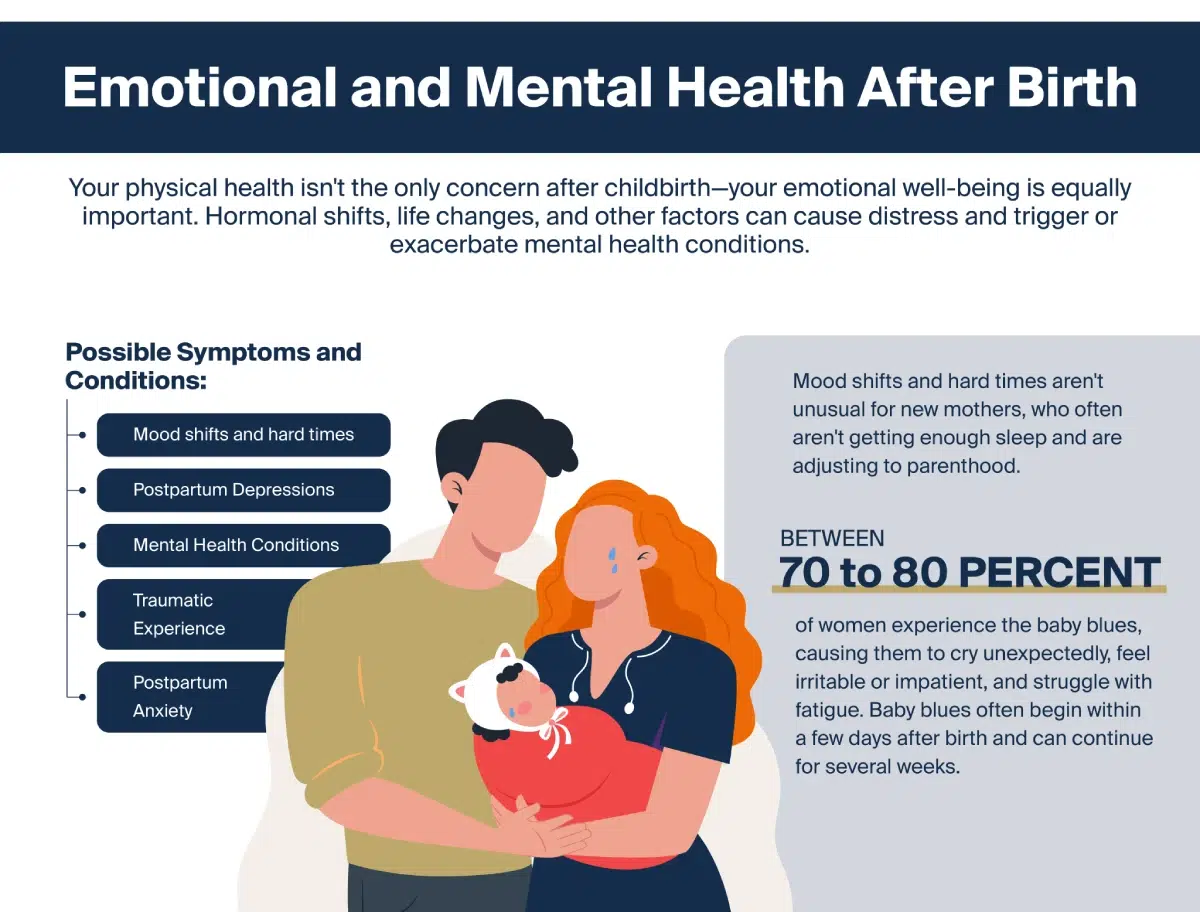
Possible Symptoms and Conditions
Mood shifts and hard times aren’t unusual for new mothers, who often aren’t getting enough sleep and are adjusting to parenthood. Between 70 and 80 percent of women experience the baby blues, causing them to cry unexpectedly, feel irritable or impatient, and struggle with fatigue. Baby blues often begin within a few days after birth and can continue for several weeks.
When these negative emotions are more serious, you may have postpartum depression. Depression makes it difficult for you to take care of yourself and your baby, and it can begin as much as a year after childbirth. Extreme sadness, anger, exhaustion, and difficulty navigating everyday life are indicators of postpartum depression.
Another mental health condition affecting some new mothers is postpartum post-traumatic stress disorder, or PTSD. This condition usually results from a traumatic or frightening experience, such as an emergency C-section or childbirth injury. Women with this condition often suffer from flashbacks, nightmares, panic attacks, and insomnia.
Anxiety is also common during the postpartum stage. If you always feel worried, have racing thoughts, can’t sleep or eat, or frequently feel nervous without an obvious cause, you may have postpartum anxiety. This condition frequently occurs alongside depression or PTSD.
When Emotions Become a Warning Sign
Postpartum mood swings usually resolve themselves within a few weeks after childbirth. Mental health conditions, on the other hand, are more lasting and can disrupt your daily life. Continuing symptoms, feelings of hopelessness and worthlessness, and thoughts of harming yourself or your baby are dangerous if you don’t address them.
If you’re struggling with your emotions, make use of one of these free helplines:
- National Maternal Mental Health Hotline, 1-833-852-6262
- Suicide and crisis lifeline, 988
- National Alliance on Mental Illness, 1-800-950-6264
- Postpartum Support International, 1-800-944-4773
In addition to calling a hotline, you may also need support from a counselor to work through mental health conditions such as postpartum depression and PTSD.
If your condition is the result of a health care provider’s neglect and failure to properly treat you, you can also pursue legal options. Filing a claim allows you to seek compensation to cover your bills for mental health treatment, as well as lost wages and pain and suffering.
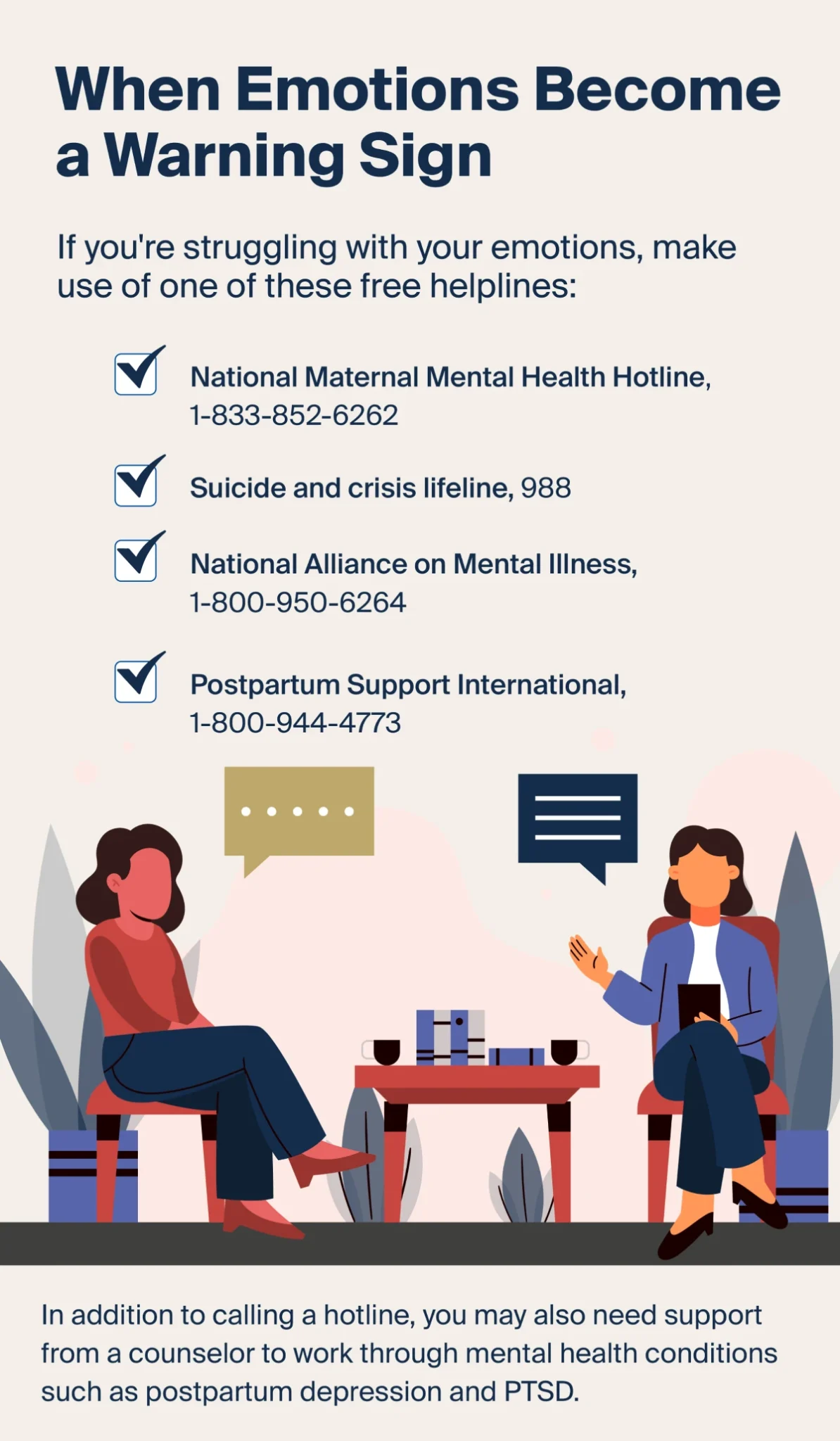
Postpartum Recovery Timeline
Each mother’s recovery is unique, hitting milestones at different points based on their overall health, complications, and support systems. However, these guidelines give you a general idea of what to expect:
- Weeks 1 and 2: You’ll likely experience postpartum cramping, also known as afterbirth pains, as well as bleeding, incision pain, and soreness. Rest as much as possible during this time and seek support from your family and friends.
- Weeks 3 and 4: As the first month comes to a close, you’ll probably have more strength, increased energy, less soreness, and less bleeding. However, some mental health conditions can emerge during this postpartum period.
- Weeks 5 and 6: Your bleeding should slow and stop in the second month, but some women have recurring bleeding beyond this point. To support your recovery, follow your doctor’s recommendations, try to exercise, and pay close attention to your postpartum diet to ensure you get the nutrition you need.
- Six months: At this stage, hair loss and other issues such as incontinence may have resolved. Your period might resume, but you may experience mental health symptoms, such as depression or anxiety.
- One year: When you hit the one-year mark, your physical symptoms are typically mostly or entirely resolved. You may still have a C-section scar and numbness around it.
Remember that your recovery may not follow this schedule exactly. However, that doesn’t necessarily mean you’re experiencing complications. Speak openly with your doctor if you feel your symptoms have continued longer than they should.
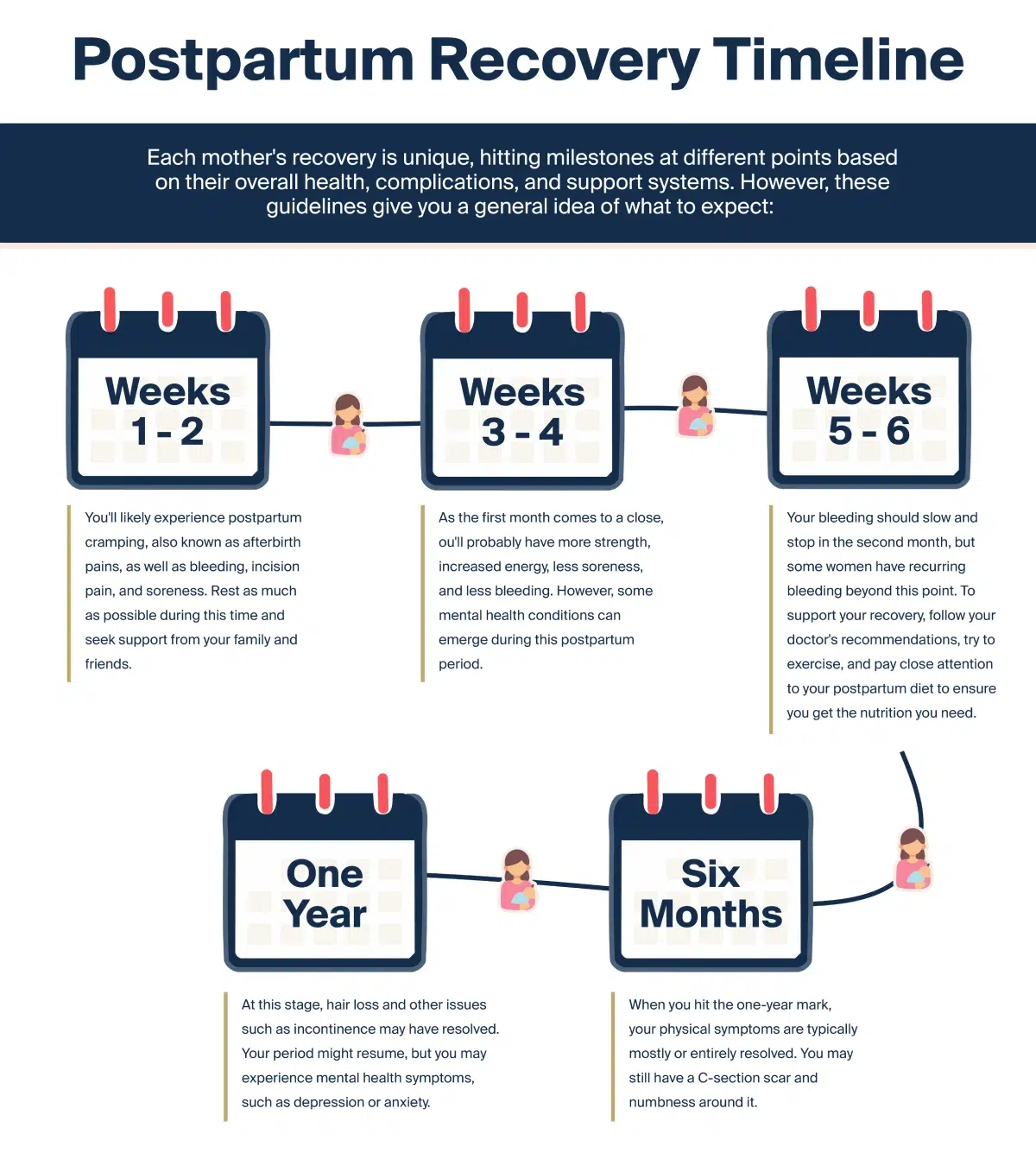
When To Contact a Lawyer After Giving Birth
The idea of childbirth is frightening for many women, particularly when they hear about other mothers’ negative experiences. Most recoveries go smoothly, but medical errors and negligence by health care providers can cause complications that make your journey more difficult and put your health or life at risk.
Common errors by your health care providers include the following:
- Surgical mistakes: The most common errors during C-sections involve anesthetics or damage to blood vessels or the bladder.
- Delayed intervention and response: A delay in responding and treating hemorrhage can result in excessive blood loss, potentially leading to organ failure, anemia, shock, and death.
- Unnoticed or untreated infections: If your health care team doesn’t monitor for signs of infection or provide appropriate postpartum care, you can experience sepsis and organ failure.
- Retained placenta: When the placenta remains partially attached to the uterine wall and a doctor doesn’t intervene, it can result in a serious infection.
If you have been harmed by negligent medical care, record as much information as you can before contacting a birth injury attorney. Keep track of your symptoms and collect copies of test results, imaging, and medical records. These documents are vital if you decide to take legal action.
FAQs About Postpartum Recovery and Legal Options
How long does postpartum bleeding last?
Postpartum bleeding can last anywhere from a few days to two months. It should become lighter in color and flow over time, with fewer clots and little to no pain after the first few days following childbirth.
What is lochia, and how long does it last?
Lochia refers to the vaginal discharge most women have after vaginal or cesarean delivery. A combination of blood, amniotic fluid, mucus, and uterine tissue, it usually lasts three to six weeks. Lochia is normal and is only concerning if you have excessive bleeding, large clots, or other symptoms, such as fever and dizziness.
When should I seek medical help after giving birth?
Seek medical help if you experience symptoms such as excessive bleeding, severe pain, a high fever, or a persistent headache. Seeing a doctor is also important if you have more moderate ongoing symptoms, particularly if they worsen over time.
What are the signs of a postpartum infection?
A high fever, dizziness, and a foul-smelling discharge are signs of a postpartum infection. If you had a C-section, you may also notice problems around the incision site, including swelling, redness, and fluid drainage.
Can I sue if my postpartum complications were ignored?
Resources for New Mothers
The postpartum stage is often overwhelming, and having access to reliable information can help you navigate your experience and feel less alone. These resources provide details about different aspects of your health and recovery as a new mother:
- Medline’s guide to postpartum care
- National Child & Maternal Health Education Program
- Depression fact sheet from the Office on Women’s Health
- Centers for Disease Control HEAR HER Campaign
- The Postpartum Health Alliance’s list of online postpartum support groups
If you’re facing physical or emotional challenges, don’t hesitate to seek help from a support group, mental health professional, medical doctor, or attorney.
